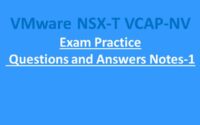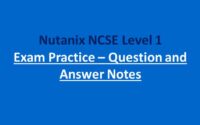July 28, 2020
Nutanix NCSE Level 1 Exam Prep Notes Part – 4
This is the “NCSE Level 1 Exam Prep Notes Part – 4” blog that covers the questions and answers I used for brainstorming and self-learning. Furthermore, the remaining once will follow in subsequent posts. Please note, these notes are based on the recommended topics mention in NCSE level 1 blueprint, the topics covered are such as
- Apply Pre-Sales Knowledge
- Match Workloads to Solutions
- Size Nutanix Solutions
- Apply Tools and Resources
Questions & Answers – Part 4
| 59 | Can node with different CPU generations can be part of the same cluster? |
| A | Nodes that use different CPU generations can be mixed in the same cluster. |
| 60 | Is it supported to mixing node within the same cluster with multiple hardware vendors? |
| A | Mixing nodes within the same cluster from multiple hardware vendors are not supported. |
| 61 | Can RDMA enabled and not enabled node to be part of the same cluster? |
| A | Nodes that have RDMA enabled cannot be mixed in the same cluster with nodes that do not have RDMA enabled |
| 62 | Can same cluster host node with NVMe drives and SSD/HDD drives |
| A | Nodes that contain NVMe drives cannot be mixed in the same cluster with hybrid SSD/HDD nodes. |
| 63 | Can same cluster host node with NVMEe and an all-SSD node that do not contain NVMe drives |
| A | Nodes that contain NVMe drives can be mixed in the same cluster with all-SSD nodes that do not contain NVMe drives |
| 64 | What is the criteria for mixing all-SSD nodes and hybrid SSD/HDD nodes |
| A | A minimum of two all-SSD nodes is required in mixed all-flash/hybrid clusters. – The minimum number of each node type (all-SSD/hybrid) must be equal to the cluster redundancy factor. For example, clusters with a redundancy factor of 2 must have a minimum of 2 hybrid and 2 all-SSD nodes. – Availability should also be considered when mixing all-SSD and hybrid nodes to ensure the minimum amount of SSD storage required for the workloads in the event of all-SSD node failure |
| 65 | Can the nodes with different amount storage capacity part of the same cluster ? |
| A | The minimum number of each node type must be equal to the cluster redundancy factor. For example, clusters with a redundancy factor of 2 must have a minimum of 2 storage-heavy nodes. – Availability should also be considered when mixing nodes to ensure the minimum amount of total storage required for the workloads in the event of storage-heavy node failure (RF2) or failures (RF3). – When mixing storage-light hybrid nodes with storage-heavy hybrid nodes, it is best practice to have an equal or greater amount of SSD capacity in each storage-heavy node as each storage-light node. |
| 66 | Does Nutanix support DARE through self-encrypting SSDs and HDDs |
| A | Yes |
| 67 | What is the list of software-based encryption supported hypervisors with Nutanix ? |
| A | AHV, ESXi and Hyper-V |
| 68 | what is a block in Nutanix |
| A | A block is a rack-mountable enclosure that contains one to four Nutanix nodes, The power supplies, front control panels (ears), backplane, and fans are shared by all nodes in a block |
| 69 | What are the benefits of block fault tolerance? |
| A | With block fault tolerance enabled, guest VMs can continue to run with a block failure because redundant copies of guest VM data and metadata exist on other blocks. |
| 70 | What is the most important item the SE must have in place with the prospect before moving forward with a POC |
| A | Defined and measurable success criteria |
Summary & Next Steps
Clearly, for passing the exam, the topics covered part of these QA notes is not enough. However, this could be a good starting point for you to get deep into each of the topics. Additionally, I would strongly recommend you to read the remaining part also to get the full scenarios and topics.
For remaining part of this NCSE-Level 1 series, please visit section Nutanix. Happy learning


